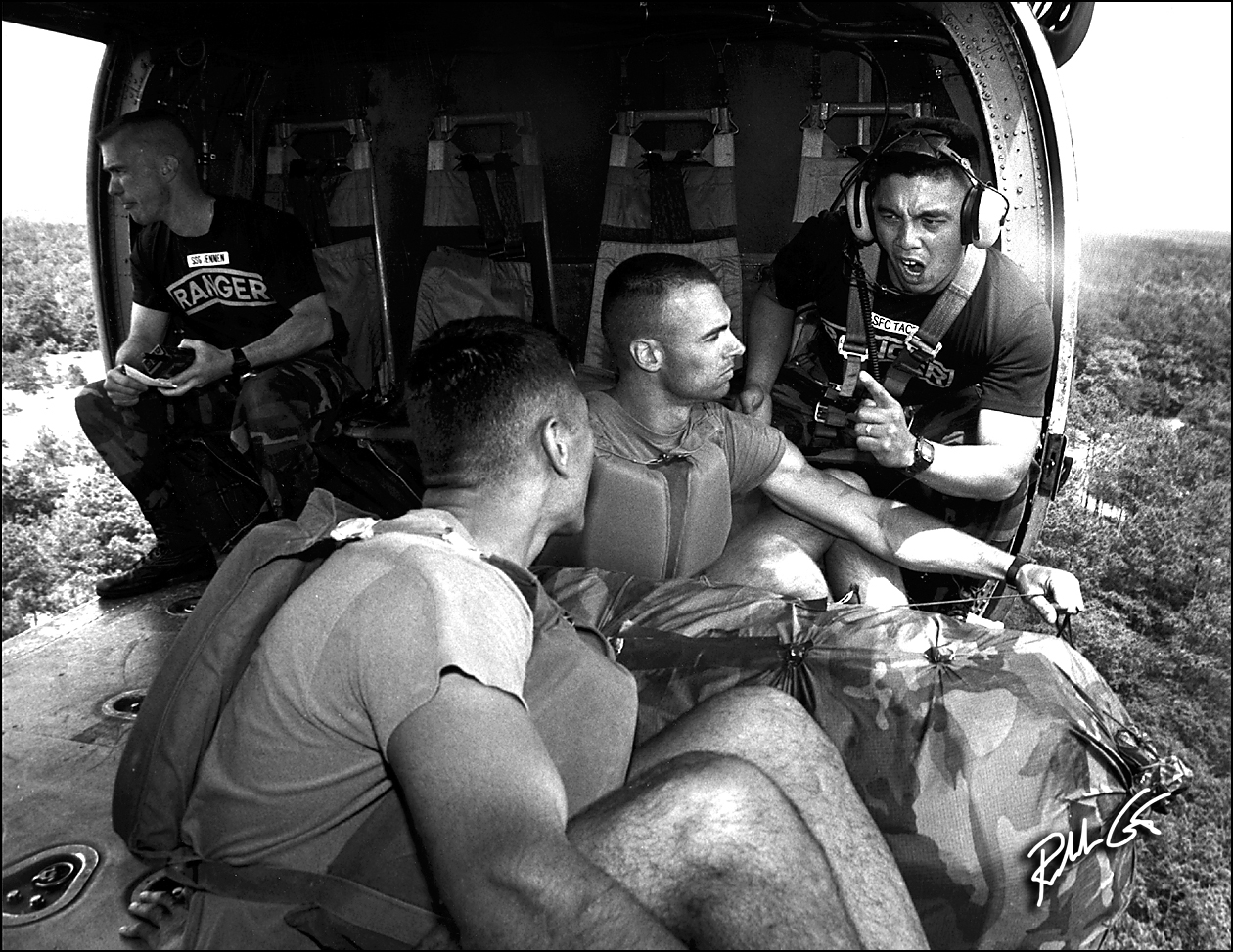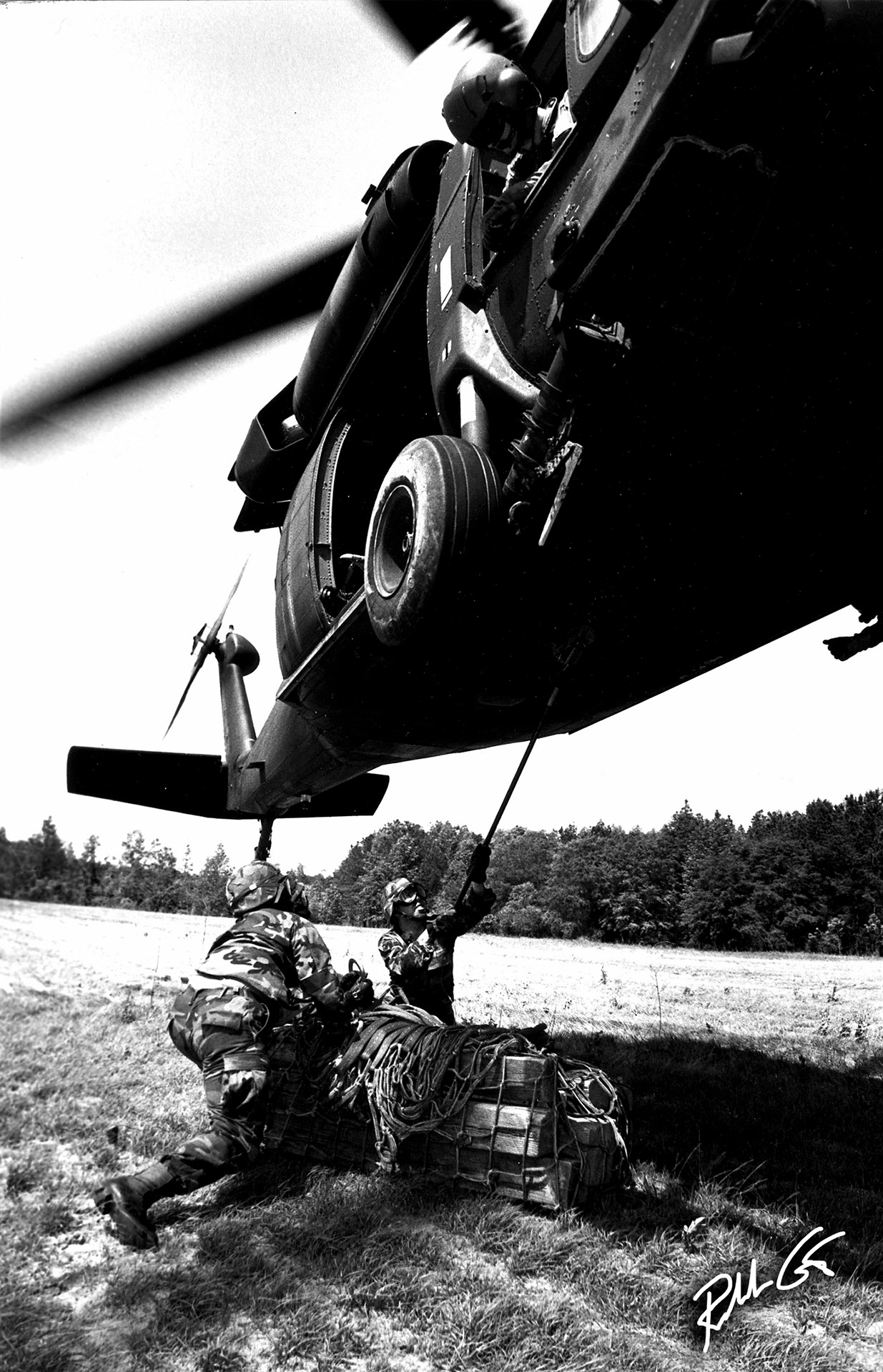Camera Shutter Release Technique is Like Shooting A Weapon
Back in my active-duty U.S. Army days, I was an expert with my M16 rifle and Beretta M9 pistol, plus I earned a German Schutzenschnur, shooting expert medal in bronze from the German Army in Koblenz, Germany. No, this isn’t an article about the pros or cons of gun control or joining the military during these troubling times, this is an article on how you can take military techniques and apply them to improve your photography.

I captured this photo at the annual U.S. Army Best Ranger competition at Fort Benning, Georgia as Army Rangers prepare for a “hellcast” jump into the lake below.
BRASS Military Technique
In all the years that I’ve taught photography workshops and supervised teams of photographers, I’ve seen many things to include photographers who jerk their cameras when they release the shutter. Yes, there are some photographers who do this intentionally for special effects, but most “jerks” take place when you release the camera’s shutter and most photographers don’t realize this happens until after they download their images.
This jerk takes place with the release of the camera shutter and leads to images that look blurry, or un-sharp, but it’s easily corrected if you use the same method the army teaches when it comes to a weapon’s trigger release. Basically, the military technique used to eliminate or reduce the jerking of a weapon when fired that ensures the shooter’s accuracy is known by its acronym as BRASS.

Notice how the railing creates a leading line to the model in the photo I captured in Maui.
BRASS stands for Breathe, Relax, Aim, Sight, and Squeeze, a term soldiers learn first during basic marksmanship weapons training in basic training. The breathe portion works in tandem with the relax part. You simply focus on a being relaxed when you shoot, then release the camera shutter button between breaths, not during the inhale or exhale portions of breathing. You learn to control your breathing to improve your shooting skills as seen in the movie American Sniper.
But before you release the camera shutter, you aim first, or in the instance of photography identify what you’re going to photograph, then you sight, or in photography compose your image frame, and after you exhale, release your camera shutter. Practice this over time and before you know it this becomes your natural method of depressing your camera shutter release button.
I can hear the sport shooters now, this photography technique aims for controlled environments, like a photography studio where you can take your time or even on location with still subjects or landscape photography. True and over time you will naturally learn to control your breathing, even when shooting sports as I did when I covered the San Antonio Spurs for five years with NBA credentials.
Finger tips count too. In the military we’re trained to use the finger-tip when pulling the trigger, as this helps eliminate any jerking along with keeping your actual pulse beat of your heart away from the trigger—it’s about reducing any type of vibrations from your body. Vibrations do cause a loss of sharpness in cameras as outlined in my articles about 10 Reasons Mirrorless Over DSLR.
Scan Your Sector Military Technique
Another military technique, “scan your sector,” or “scan your lanes” taught during weapons training ensures the area you’re assigned to watch is covered and not just one specific spot in that area. Normally soldiers have an area of responsibility they observe for enemy targets and they are given left plus right end points. Obviously in photography we’re not looking at the enemy unless you’re a combat photographer, as civilians we look for the best angle of view, but this term teaches you to look at what you see in a given area, beyond an obvious point.
As an example, when you have a landmark and a human subject the typical photographer will place their subject next to the landmark and while this works great for tourists, great photographers stay away from the obvious. When you scan your sector, you can do this too. Look for things like a nice set of steps that can create leading lines to your subject, then in the background, use juxtaposition to include the landmark.
Sometimes the obvious, in this case the landmark, prevents us from seeing what really exists that can provide a stronger photograph. When you learn to “see” by scanning your lanes, or sector, you’ll find interesting slivers of interesting light too, not just objects.

I captured this photo during U.S. Army Pathfinder training. Notice the soldier first “discharges” the static electricity from the Blackhawk before they sling load.
The Ends, Ways and Means Military Technique
The ends, ways, and means, another military technique about the ends will provide a strategic outcome through the ways and means. The ways are the methods, practices and strategies to arrive at the ends while the means are your resources, or in the case of the military, troops, weapons, budgets, politics and time. The whole equation, Ends = Ways + Means, is to balance your needs with your resources. What are you willing to sacrifice and at what costs to get what you want?
When analogized to photography consider the ends as the final photograph you are trying to capture and the ways as the how you will achieve that result. This includes the selection of the correct exposure based on aperture and shutter speed for that specific capture, plus your lens choice, white-balance, and ISO selection. The means refers to your photography equipment plus the location needed to achieve the ends you’re after.
Drill Sergeant Military Technique
The drill sergeant military technique mirrors the repetition technique used in business strategy when it comes to persuade a customer. Drill sergeants “drill” in your head what they teach you and they do this through repetition combined with the Pavlov Theory, or respondent conditioning. Basically, if you do something wrong you are punished, usually with pushups in the military, and if you do something right you are rewarded, like a weapons’ badge for the military uniform when you qualify for as a marksman, sharpshooter or expert with your weapon.
This military technique provides a fast way to learn forward to improve an outcome. The same applies to photography. Enter a photo contest, if you’re on top of your game chances are you’ll be rewarded—if not, then perhaps you need more repetition, or practice, and practice makes perfect or close to it. Bottom line, you learn, improve, and stay proficient when you practice your craft. The rewards come with acceptance of your photography by your clients or your intended audience.
Mission Essential Task List aka METL
A mission essential task list, aka METL, “consists of a short-numbered list of generic task statements. Some tasks may be broken down into separate types of tasks.” Basically, it’s a comprehensive short list of tasks used to complete a mission. While METL is more wartime oriented, in photography we can use this concept to reach our photographic goals and become better photographers.
For example, a METL for a photographer may go like this:
- Comprehension: Understand the basics, fundamentals and principles of photography including understanding my equipment thoroughly plus what it takes to make a great photograph through proper exposure, composition, and execution.
- Communication: Understand that ability to communicate with my subject and intended audience.
- Creativity: Understand that not everyone is born with a creative eye, but that it takes creativity to achieve a great photo, so if I lack it, I will improve on it.
Probably the first time I’ve expressed the use of METL in photography as I’ve written about “The Three C’s of Being a Great Photographer” in several of my photography books. Take a good look at one of those C’s and if you’re lacking in anyone of them, then it’s up to you to improve upon it, and in the military, they call that act discipline—doing what you’re supposed to be doing when no one is watching.
The end result isn’t about winning a battle, it’s about establishing your photographic style and practicing good photography habits to achieve great photographs, not just mediocre photos and the use of military techniques can help you get there or improve your current photography.



